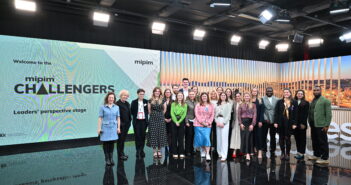As Mihir Shah, Co-CEO of newly founded JLL Technologies, said at the time of the launch of JLL’s new division this September: “We are leveraging technology to increase the value and liquidity of the world’s buildings while enhancing the happiness and productivity of those who occupy them.”
As an example in the field of transactions, the authors of The Future of Real Estate Transactions, published by Saïd Business School, University of Oxford, earlier this year, wrote that it was conceivable that at some point in time: “We will rely on automated valuation models with access to digitalised IoT and geolocation data held alongside ownership rights in a property passport maintained by property owners.”
Such predictions are to be welcomed. Proptech is – or should be – about identifying the pain points in the structures and processes of the real estate industry and bringing forward a solution. The pain points are many. As an example, the Said Business School report points out that conveyancers in the UK are undertaking 55% more work per person than in 2015, the average sale takes 11 weeks and a quarter of all property transactions fail to complete.
While the scope for proptech is immense, so are the rewards – the creation of healthier balance sheets for investors and occupiers, and a more sustainable world, socially and environmentally.
JLL launches JLL Technologies to accelerate innovation
This September, JLL, the global real estate provider, launched JLL Technologies, designed to align and expand its technology and digital initiatives. The move is about accelerating innovation in commercial real estate for JLL’s investor and occupier clients.
The new venture is headed jointly by Yishai Lerner and Mihir Shah, previously Co-CEOs of JLL Spark, JLL’s global technology venture fund, which now comes under JLL Technologies.
When Shah joined JLL Spark in 2017, the year before the fund was launched, and after a career of 22 years in Silicon Valley, everyone in the Valley had one question: “Why real estate?’”
Together with Lerner, Shah has been an angel investor and advisor to a number of start-ups, including Uber in the early days. “We saw what technology had done to the transportation sector. When we started looking at the commercial real estate sector, we realised that there were similar opportunities: it was a massive industry, a massive asset class and, from a value perspective, somewhat untouched by technology.”
Since then, backed by US$100mn of global venture funds, JLL Spark has invested in 16 start-ups. Recent new members to the JLL Spark portfolio include:
- Software Motor Company, which combines a “revolutionary” motor with IoT building automation technology to optimise efficiency as well as minimise carbon impact.
- OpenSpace, which uses patent-pending AI to automatically create navigable 360-degree photo representations of any physical space, in the style of Google Street View, by attaching a small camera to a builder’s helmet.
- Hubble, a London-based start-up which is building the “world’s largest online office broker.”
Talking proptech at MIPIM
Mihir Shah, Co-CEO, JLL Technologies, was on the Talking Proptech panel session at MIPIM 2019. Here are some extracts from what he said:
Mihir Shah: In the first year that JLL Spark was in this industry, we saw a lot of real estate folks starting tech companies. We’re now seeing a lot of experienced tech entrepreneurs starting tech companies focused on the real estate sector. This is testament to the opportunity in the industry.
JLL Spark is a little different from the traditional venture capitalist firm as we have an investment team and we have a growth team. The growth team takes a portfolio company and asks, “how do we get your technology into the hands of all the people in the real estate industry, the JLL clients?”
“JLL Spark is the bridge between the technology start-ups and the real estate industry, helping to pick the best of breed from among the start-ups” – Mira Shah, JLL Technologies.
That’s our value add. JLL Spark is the bridge between the technology start-ups and the real estate industry, helping pick the best of breed from among the start-ups. We help our real estate clients identify and focus on the areas of their business where the use of software would enhance their operations.
To what extent is it all happening in Silicon Valley?
MS: Out of our 16 portfolio companies, 10 are US based, two are in the UK: Hubble and Orbital Witness. We have three portfolio companies where half the operation is based in Israel and half in London or New York. One company is co-headquartered between New York and Norway.
We see a lot of opportunity for tech companies that are starting outside Silicon Valley. Silicon Valley can be an expensive place to start a technology company. If you look at Berlin, even London, the cost of technology talent is more reasonable than it is in Silicon Valley. So,
How do you see the influence of AI and machine learning coming through?
MS: Silicon Valley is famous for its hype curve. AI and machine learning are two phrases probably at the peak of this curve. You have to separate the valuable AI and machine-learning start-ups from ones that just put it in their name.
“What we’re starting to see is companies that take this data and combine it with publicly available data to understand the value of a building” – Mihir Shah
The buildings themselves generate a ton of data, whether about energy usage or space utilisation. This is very valuable in understanding the value of a building. Transactions also generate a ton of data. What we’re starting to see is companies that take this data and combine it with publicly available data to understand the value of a building.
For example, we have an investment in a company called Skyline. When they first pitched to us, it was like magic. They came to our office and said, “name a multi-family building valued at between US$50m-US100m,” and we gave them an address. They typed the name into the Skyline AI interface, clicked a button, and within seconds we had an entire valuation model. That’s an example of where we see a lot of promise.
Is there an equal appetite for proptech from investors and occupiers?
MS: When we started JLL Spark, proptech was being driven by occupiers, especially big occupiers interested in space maximising utilisation. In the JLL Spark portfolio, we have VergeSense, which installs a machine-learning camera in your office which detects space utilisation and then tells you about how the space is being used.
“[Large] investors are especially interested in tenant-experience platforms” – Mihir Shah
Over the last year, we have seen a shift, with large investors, with massive portfolios, becoming increasingly interested in technology. These investors are especially interested in tenant-experience platforms such as HqO, another start-up in the JLL Spark portfolio. The app helps occupiers connect with the property management of the building. Owners of buildings have started to feel that they have to offer solutions like this to stay competitive.
For listed companies and pension funds, it’s a lot harder to generate the capital funds without a clear return-on-investment (ROI) case. Do you see that as a challenge that’s likely to slow down innovation from the investor world?
MS: Generally, big investment groups will do a RFP (request for proposal), taking months to vet everything, before making a big company decision. Instead, we have encouraged our clients to pick a few buildings in their portfolio, which they think are technology forward, and to do a pilot. If you’ve made a mistake, and you don’t see the ROI, it’s not going to cost you that much. Once you’ve seen a couple of pilot buildings doing well, then you can make a broader investment decision. This really changes the game. It’s good for investors, and it’s good for start-ups as it forces them to demonstrate ROI.
“We have encouraged our clients to pick a few buildings in their portfolio… and to do a pilot” – Mihir Shah
Which cities are more open to innovation than others?
MS: It’s not so much about which cities are the most innovative; it’s about the people in charge of making the decisions at the investor level – to the personality and tech forwardness of individual decision makers, and whether they are willing to take responsibility for going ahead. We see this kind of person in every city. It’s about identifying what I call the ‘graph of the early adopters’ within different investment groups.
If you’re a start-up, it’s about value; you have to show ROI. Initially you can get adoption because you have the hype and the hype cycle, but after a couple of years, when you’re in let’s say 100 buildings, if you don’t show ROI, you’re done.
“It’s about identifying what I call the ‘graph of the early adopters’ within all of these different investment groups” – Mirih Shah
Are you seeing technology that’s trying to address environmental issues?
MS: Over the last year, we have seen a number of companies trying to address energy utilization in buildings. They take a variety of approaches. Some of them have hardware that they’ll put into the building to reduce energy usage, such as Software Motor Company, which we have just invested in. Other companies take a building’s existing data and try to understand patterns in order to reduce energy usage.
Neither of these types of company have taken off at scale because I don’t think they’ve yet shown the kind of consistent ROI that would cause owners or occupiers to say “this is a must-have.” At the moment, they’re still in the “nice to have” category.
The influence of blockchain, or other forms of tokenisation, on real estate?
MS: We meet so many blockchain start-ups that attach a user case on real estate. We always tell them: “You have to identify a pain point for people in the real estate industry, and then determine if blockchain is the most efficient way to solve it.”
“You have to identify a pain point for people in the real estate industry, and then determine if blockchain is the most efficient way to solve it” – Mihir Shah
I would say we’re still trying to find someone that’s more driven from that angle than not. That said, in the case of institutional cross-border transactions, for example, there is value in using something like blockchain to accelerate transactions, increase security and build trust between parties.
We have not seen a company yet to break out in this category. Only a lot of noise.
What makes a building smart?
MS: Being smart is about the utilization of data to enhance the experience of the owner and occupier. We’re not there yet. Buildings are already generating a lot of data. That’s been happening for a long time. But how many buildings can we say have truly achieved that dream of the data setting both the occupier and the investor free, if that is the vision?
“How many buildings can we say have truly achieved that dream of the data setting both the occupier and the investor free? “ – Mihir Shah
A smart building is where you can harness all this data to help the building do two things. First, to improve the experience of the people who occupy the building. For example, when I’m a visitor why do I have to wait in line to sign in? Why can’t I just get a message on my phone that welcomes me to the building? Second, to take this data and use it to save energy or make it easier to transact on the building. At present, people are trying out different use cases and experimenting.”
The final word from Said Business School
In a final warning from Professor Andrew Baum, Co-author of The Future of Real Estate Transactions is about valuing data: “Sooner or later our property data could either be democratised or monopolised by technology firms. The real estate market of 2030 could look very different, and it is of vital importance that the industry understands what the future holds.”



